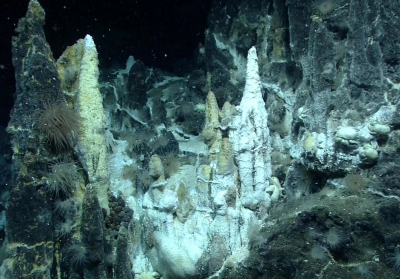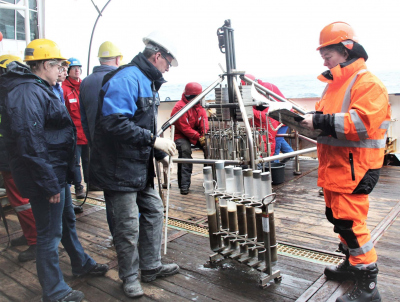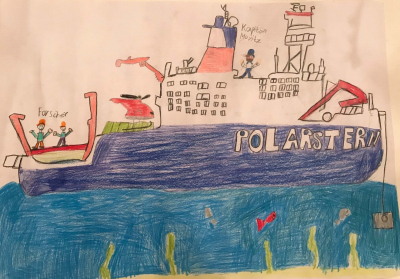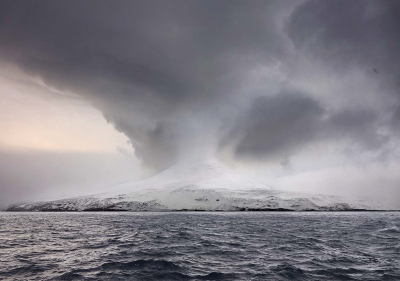- Home
- Research
- Expeditions
- 2019
- PS119
- PS119 – 4th Weekly Report
Active volcanoes of the South Sandwich Island Arc
PS119 – 4th Weekly Report, 29.4. – 5.5.19
We started the new week on Monday, 29th April, with a long dive to sample smoking chimneys and vent animals in the known hydrothermal field of the segment E2-South. Here we concentrated our efforts on the active vent systems around Dog’s Head, a complex structure consisting of four chimneys, nicely lined up one after the other, fused on their bases and characterised by single black smoking orifices in 12 to 15 meters height.
South of Dog’s Head, several extinct relict chimneys and active fluid smokestacks cluster, that are colonised in very different patterns by anemones, snails, yeti crabs, and other organisms. Obvious are especially the white bacterial mats covering single chimneys like snow-covered mountains.
Our specialised fluid sampler made from chemically inert titanium enables us to collect the extruding fluids from two black smokers. The fluid samplers are gas-tight, i. e. that gases cannot escape while the ROV rises and the pressure drops, and we are able to measure the gas concentrations onboard in a gas chromatograph. The snorkel of the fluid sampler used to collect the hot fluids from the opened orifice in a much-directed way, is linked with a temperature sensor, so that we can measure the precise fluid temperature. The first sample was hot and contained high hydrogen and methane concentrations in its gas phase. Only about half of the former gas concentrations were measured in the second fluid sample, which was collected from a site with an exit temperature of 344°C. These high temperature measurements are only measured in the fluid flow directly in the exit orifices, while the surrounding seawater is only slightly warmed up. The off-vent seawater on the seafloor of this oceanic region has a temperature of 0°C, which can rise up to a few degrees Celsius, depending on the proximity to focused and diffuse flow exits.
Next to the fluid samples, we also collected rock samples of the chimneys, that were taken with the manipulator arms of ROV QUEST; these contained, next to anhydrite, shiny metal sulphide minerals, like chalcopyrite, pyrite and sphalerite. Overall, it was a very successful dive, actively followed by our colleagues in Bremen as the telepresence link enabled this. The following night was used to survey the area for suitable sediment corer positions, which we discovered in different water depths in sediment-covered basins between tectonic high blocks of the magmatic crust. Two sediment-coring positions were selected, which we sampled on Tuesday, 30th April, with gravity corer and multicorer.
The investigation of the pore waters in these sediment cores and in those of the past days, together with the chemistry of the iron minerals, will contribute to the charting of the “plume”-like drift of the iron minerals originating from the hot springs in the surrounding. In the night from Tuesday to Wednesday, we surveyed the seafloor on a line from the spreading centre E2 to the East, crossing the island arc of the South Sandwich Islands north of Zavodovski Island over the fore-arc area into the deep-sea trench of the South Sandwich subduction zone. This zone in its northern part is especially deep and reaches a depth of 8,264 m in the so-called Meteor Deep. The German survey vessel Meteor I discovered the deep on its southernmost West-East transect during its expedition in 1925-1927 and mapped it as deepest area of the South Atlantic.
Starting with a CTD profile including water sampling to measure methane concentrations, Wednesday, 1st May, was not only a public holiday but also our captain’s birthday. The pupils of class 3a of the city borough school Wilhelmsburg, which follow our expedition in Hamburg with the subjects polar- and marine sciences, noted this occasion with drawings which they presented (via the internet) to our captain. Those drawings then were hanging in our mess room on the wall next to the captain’s table, including a drawing of RV Polarstern, admired by all of us on board.
Again, a night and a morning were used surveying the seafloor of the fore-arc and in parallel searching for indicators of fluid and gas exits, while we were steaming southward bound until we reached Saunders Island, the target of our volcanologists, in the afternoon. This volcanic island is the third largest of the South Sandwich Islands, which are running from North to South in an eastward bend arc parallel to the deep-sea trench.
While the northernmost volcanic islands with Russian names, had been discovered by Admiral Fabian Gottlieb von Bellingshausen, James Cook discovered the southern islands and gave them British names. Mount Michael on Saunders Island is, like many of these island volcanoes, active and partly reveals itself only after a while.
Neither the planned surveying of the island by drones nor a visit of our volcanologists to the island was feasible due to bad weather; therefore, we surveyed the seafloor of the island in closer and closer circles, hoping this improved seafloor mapping will support a future landing and enable the volcanic research project.
All on board are well. Best wishes in the name of all cruise participants,
Gerhard Bohrmann, RV POLARSTERN, Sunday, 5th May 2019






